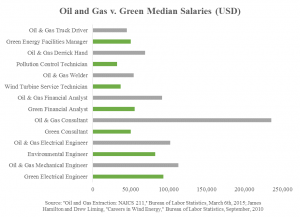Oil and Gas v. Green Jobs
On February 24th, President Obama vetoed the Keystone Pipeline, citing that such a project is “not in the national interest” ― and instead the President has been a vocal proponent of creating green jobs in alternative energies. However, it is vital to analyze the quality and effect of these jobs. When comparing the jobs created by the oil and gas industry to the emerging green energy industry, what considerations should be made?
The first and most simple is salaries:
It doesn’t take a scientist to see that typically, members of the oil and gas industry are paid much more than their counterparts in green-collar jobs. It’s extremely important to note that above “Oil & Gas Financial Analyst,” jobs are no longer directly comparable, because they’re more specialized blue-collar jobs.
Ironically, apart from being paid less than other jobs in oil and gas, every single blue-collar job in the green energy sector required an undergraduate degree (except for “Wind Turbine Service Technician,” which only required work experience or specialized certifications). From a purely financial point of view, it’s a significant investment with a lower return. Oil and gas lend greater support to unskilled, blue-collar workers. What is this higher pay in oil and gas attributed to? Is the oil and gas industry simply more lucrative? Conventional wisdom may lend itself to this idea, but there is also another component in the equation.
Industry reports from the Bureau of Labor Statistics (BLS) seem to point to a high risk premium that is implicitly included in the pay for oil and gas workers. The Survey of Occupational Injuries and Illnesses by BLS shows that workers in the oil, gas and mining industry have a probability of nonfatal injuries that can be as high as 36 percent, particularly in smaller companies. This statistic, translates into a higher than average probability of injury, disability, chronic illness and death for workers within the sector. Employees in the oil and gas industry also report lower levels of job satisfaction. From a quantitative perspective, the decision to be for or against nonrenewable energy is clear. From a qualitative perspective, we should at least give this question pause.

If the Keystone Pipeline should be built then the nation would be more able to provide the subsidies that are necessary to keep the parasitic green energy crony socialist boondoggles afloat financially.
The sheer number of jobs in the oil & gas industry is much larger than in so-called “green energy.” For instance, highly subsidized “clean energy” created 80,000 jobs nationwide in 2013, according to a report on Clean Technica (http://cleantechnica.com/2014/03/14/clean-energy-created-nearly-80000-green-jobs-in-america-during-2013/); however, rebounding from the 2007 recession, “more than 400,000 jobs have been created in direct production of oil and gas and two million more in indirect employment since 2003. Now, one million Americans work directly in the oil and gas industry, and ten million jobs are associated with that industry.” (http://www.economics21.org/commentary/where-are-jobs-oil-and-gas).
Hey Joe,
I completely and 100% agree. The oil & gas industry do produce many more jobs! It is important – I think – to also scale these results. The oil industry and even natural gas are much older, they were around during industrialization. Furthermore, production capacity for natural gas and oil is much higher not only because the energies are economically efficient but because there is more infrastructure for extracting the two energies, this is partially reflected in production:
http://environmentblog.ncpathinktank.org/evolving-energy-infrastructure-energy-battles-looming-at-home/
This large infrastructure is very labor-intensive, hence the jobs. Comparing aggregate quantities from oil & gas with that of renewables is like comparing the number of accountants in New York vs. El Paso.
For employment, perhaps there should be more research done on jobs provided per kind of facility. It could be that a wind farm requires much fewer workers than an oil rig, for example.
I’m sure the EIA has more datasets to help illuminate the issue.